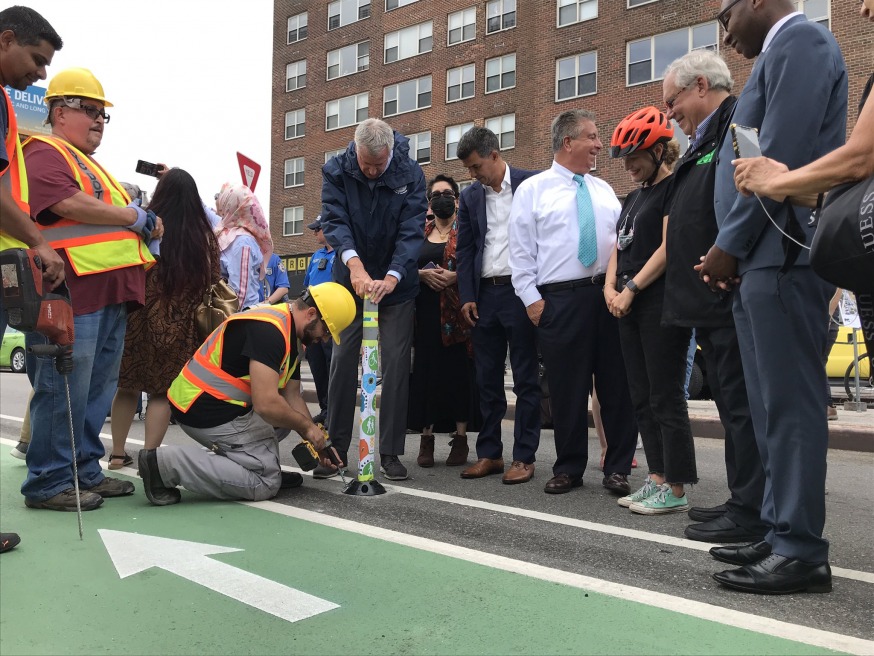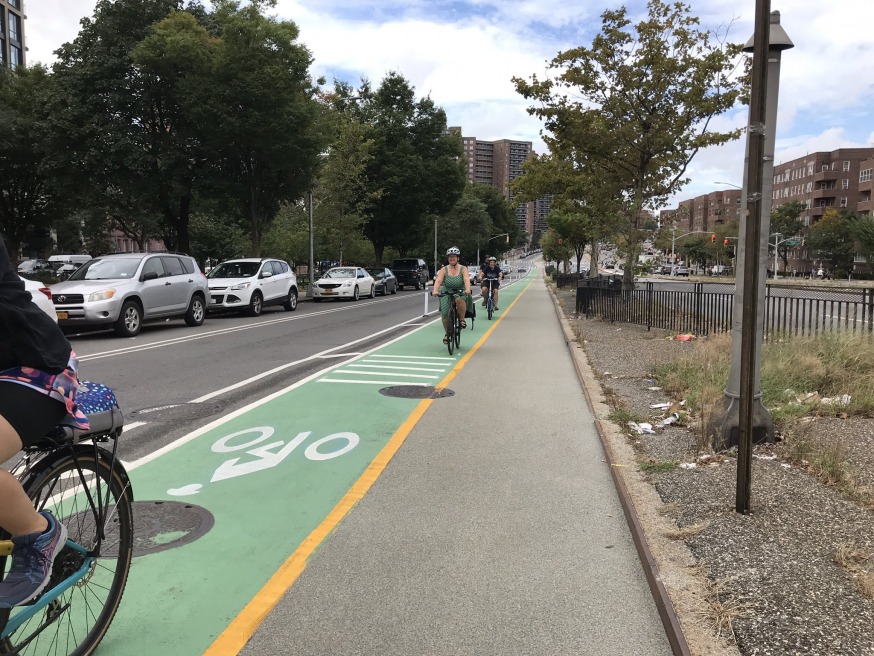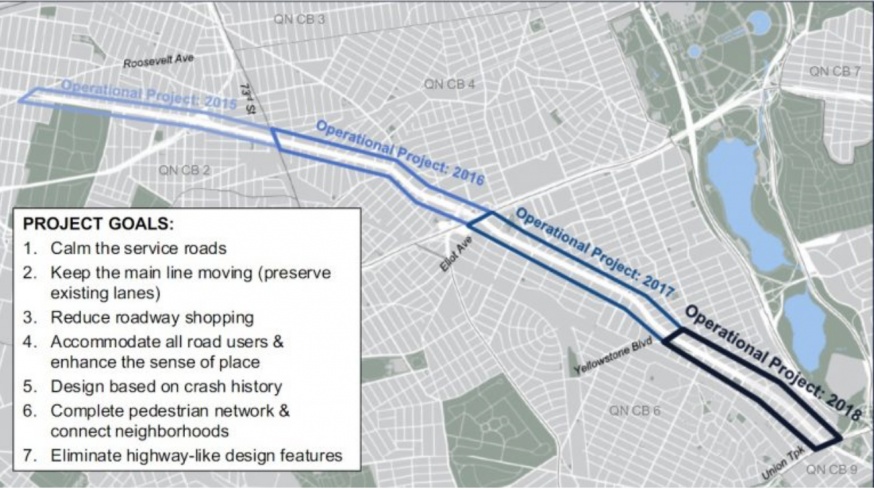
Mayor Bill de Blasio helps a worker install a partition along a section of new bike lanes on Queens Boulevard (DOT via Twitter)
Sept. 22, 2021 By Allie Griffin
The final phase of the Queens Boulevard redesign project will be completed next month, Mayor Bill de Blasio announced at a press conference on Queens Boulevard in Forest Hills Wednesday.
The fourth and final phase — from Yellowstone Boulevard to Union Turnpike — will be finished by Oct. 29, according to the DOT.
De Blasio touted the completion of Phase 4 — which adds protected bike lanes, shortened pedestrian crossing and other traffic safety measures to the stretch in Forest Hills — as a victory of his signature Vision Zero initiative.
However, the project’s completion is long overdue. Construction of Phase 4 was supposed to begin in summer 2018 and be completed that year. The plan was delayed two years due to local opposition and then the pandemic pushed back the work another year.
The city announced in May that the plan would be completed in November — which has now been replaced with an October end date. Construction on Phase 4 started in early August.
“We’ve waited too long for the Queens Boulevard redesign to be completed, but the end finally is in sight,” Queens Borough President Donovan Richards said on Twitter. “Proud to join @NYCMayor and @NYC_DOT to announce that in one month, we’ll have two more miles of protected bike lanes and safer streets for drivers, cyclists and pedestrians.”
The final phase of the redesign project was controversial. The plan faced resistance from Community Board 6 and Council Member Karen Koslowitz.
The community board and Koslowitz expressed reservations about the plan since the project will remove about 200 parking spots. They feared that the loss of parking spaces would hurt businesses located along and near the boulevard.
Community Board 6 voted against the plan in 2018, citing the loss of parking spaces.
Koslowitz put forward an alternative plan in February 2020, which de Blasio agreed to review. Her plan, she said at the time, would save many of the parking spots. Transit advocates, however, said her plan was not as safe as the DOT’s redesign and that there was no evidence businesses would suffer under the original DOT plan.
The DOT stuck with its plan.
The completion of Phase 4 will mark the end of the 7.5-mile redesign of Queens Boulevard that began in Sunnyside in 2015 and will finish in Kew Gardens in October.
“New York City is proud to complete the redesign of one of Queens’ most important roadways – and give new life to the notorious ‘Boulevard of Death,’” de Blasio said at the press conference. “Safety improvements like these make our city more livable for everyone who uses our streets – and they recognize that our responsibility is to make sure a car doesn’t turn into a weapon.”
The thoroughfare has been called the “Boulevard of Death” for decades for the notoriously high number of cyclist and pedestrian deaths along it.
However, traffic injuries along the already-redesigned sections of Queens Boulevard have declined by 19 percent and severe injuries by 38 percent, according to the DOT. There have been a total of five traffic fatalities along the boulevard since 2016 — compared to 22 traffic deaths in one year, 1997, alone.

Sections of the new bike lanes along the boulevard have already been completed (DOT via Twitter)
“It’s so satisfying to see green paint going in on the protected bike lane and new pedestrian safety improvements going in along this stretch of Queens Boulevard in Forest Hills, after witnessing the great benefits of this project’s previous phases,” DOT Commissioner Henry Gutman said at the press conference.
Phase 4 includes the creation of new protected bike lanes and a pedestrian path along the medians between the service road and the main roadway. It also includes new and improved crosswalks at intersections; new stop controls at slip ramp access points; and elongated left-turn bays for simpler, safer turns.
The DOT is also adding 10 new truck loading zones — as well as adding hours at existing zones — and 22 parking spaces in commercial areas near Ascan Avenue and Austin Street.

The Queens Boulevard redesign goes from Sunnyside to Kew Gardens. Phase Four was expected to be completed in 2018 but will now be done by October (DOT)
2 Comments

Not meaning this pro or con in regard to bike lanes, just correcting a false attribution as to what stopped Queens Blvd. from being as dangerous as it used to be, which was the DOT increasing time for pedestrians to cross.
The term Blvd. of Death was unrelated to bicycles. The deaths occurred primarily because crossing lights were shorter. For years, the DOT refused to lengthen them, saying that Queens Blvd. was a crucial passage for traffic flow as it was. The day after the DOT lengthened the crosswalk timings, after years of requests, the deaths virtually stopped. Local officials were credited.
Prior to that, the city had even tried a day of tickets for jaywalking to stop pedestrians from trying to get across against the light, but it did not help.
With less parking, longer commuting time, higher meter fees, its so much easier to just order on line and let someone else find a parking space.